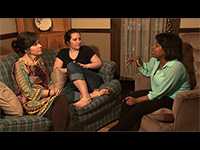Signs and Symptoms
Women and Bleeding Disorders: Living with von Willebrand Disease
Meet three women and hear about their experiences living with von Willebrand Disease (VWD). Learn about the signs and symptoms of VWD and why it’s important to seek help with any questions or concerns about abnormal bleeding.

Fact Sheets
Signs and Symptoms
Download and print this fact sheet »
Screening Tool for Identifying Women with Menorrhagia for Testing and Evaluation for Underlying Bleeding Disorders
Signs and symptoms of a bleeding disorder:
- I have heavy menstrual periods, such as:
- Bleeding for more than 7 days from the time bleeding begins before it completely stops.
- Flooding or gushing of blood that limits daily activities such as housework, exercise, or social activities.
- Passing clots that are bigger than a quarter.
- Changing a tampon or pad, possibly even both, every hour or more often on heaviest day(s).
- I have been told I am “low in iron” or I have received treatment for anemia.
- I have experienced heavy bleeding after dental surgery, other surgery, or childbirth.
- I have experienced prolonged bleeding episodes that might occur as a result of:
- Dental surgery, other surgery, or childbirth;
- Frequent nose bleeds (longer than 10 minutes);
- Bleeding from cuts or injury (longer than 5 minutes); or
- Easy bruising (weekly, raised, and larger than a quarter in size).
- I have experienced prolonged bleeding episodes such as might occur as a result of:
- Dental surgery, other surgery, or childbirth;
- Frequent nose bleeds (longer than 10 minutes);
- Bleeding from cuts or injury (longer than 5 minutes); or
- Easy bruising (weekly, raised, and larger than a quarter in size).
- I have one or more of the bleeding symptoms above and someone in my family has a bleeding disorder such as von Willebrand disease or a clotting factor deficiency such as hemophilia.
If you have one or more of these signs and symptoms, please talk with your doctor or other health care professional. You might even print out and complete this questionnaire to bring to your next doctor’s appointment. Bleeding disorders can be dangerous if they are not treated. Women with untreated bleeding disorders face serious risks after childbirth, dental surgery, other surgery, or injury.
Bleeding disorders can be treated, but first you need to know if you have one!
- Page last reviewed: November 28, 2016
- Page last updated: December 10, 2014
- Content source:


 ShareCompartir
ShareCompartir